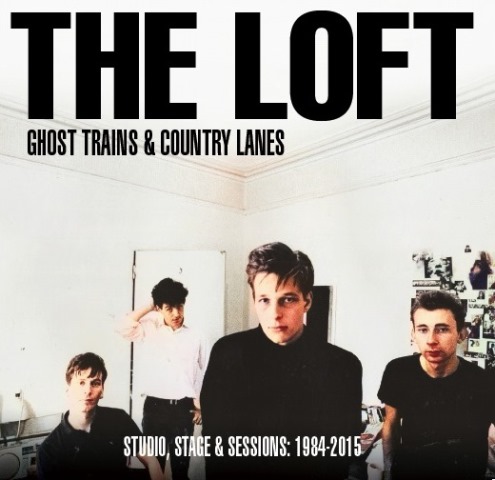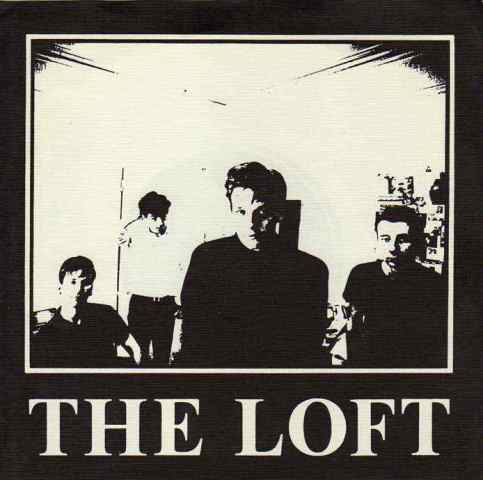Reissue CDs Weekly: The Loft - Ghost Trains & Country Lanes | reviews, news & interviews
Reissue CDs Weekly: The Loft - Ghost Trains & Country Lanes
Reissue CDs Weekly: The Loft - Ghost Trains & Country Lanes
The ill-fated early Creation Records band gets anthologised

“All the best bits of Dylan and the Velvets with a post-punk Eighties edge to it.” That’s how Alan McGee described The Loft to NME in November 1984. Their first single, “Why Does the Rain”, had come out on his Creation label that September. Their next, “Up the Hill and Down the Slope”, arrived in April 1985.
It was some claim. The interview coincided with the release of the debut single by another rising Creation band, the Jesus and Mary Chain. McGee went on: “Jesus and Mary Chain are the shock troops in this war on pop, they'll smash down doors which more subtle bands like The Loft will discreetly sneak under.”
 As it happened, there was no sneaking under. Those two Loft singles were all that they issued. Across their various formats, there were seven tracks in all. Add in a BBC session recorded for the Janice Long show in December 1984, and that was all that anyone could hear of what The Loft sounded like in a recording studio.
As it happened, there was no sneaking under. Those two Loft singles were all that they issued. Across their various formats, there were seven tracks in all. Add in a BBC session recorded for the Janice Long show in December 1984, and that was all that anyone could hear of what The Loft sounded like in a recording studio.
These ’84/’85 tracks form the foundation of Ghost Trains & Country Lanes: Studio, Stage & Sessions (1984-2005), a new double-CD Loft retrospective, their third (!) compilation. Its cover re-uses the band photo first seen on their debut single's sleeve. The by-now usual core material is supplemented by an OK-sounding audience recording of an engagingly confident show taped on a Sony Pro-Walkman on 8 June 1984 at the London pub venue booked by McGee. There’s a fair amount of background chat: a bootlegger’s A- quality. There are also 10 tracks from 2005 and 2015 reunions (a demo session and a set of radio recordings).
For the original-era band, the end came on 24 June 1985. On stage at London’s Hammersmith Palais, while supporting Terry Hall’s band The Colourfield, intra-band tensions came into the open. According to the band’s website, before the show “[frontman] Peter Astor informed bassist Bill Prince over the phone of his wish to sack him and guitarist Andy Strickland and continue with drummer Dave Morgan under the same name. After Prince told Strickland of the call, Strickland demanded that Astor be present for the gig. Astor showed; prior to the final song of the band's set, Strickland foiled the singer and told the packed crowd that The Loft would be no more after that show.” With bitter-sweet timing, later that week music weekly Sounds ran an article on Creation which commented on The Loft’s “bright future.”
Although The Loft’s lifespan was limited and abruptly curtailed, they were obviously a fertile hothouse for some major talents. Members went on to The Caretaker Race, The Weather Prophets and The Wishing Stones. Peter Astor has made heaps of great records. And there was a form of afterlife: “Why Does the Rain” was in The Loft's repertoire (heard here in the live set) and was later recorded by The Weather Prophets.
 Back when The Loft were extant, McGee’s hubristic, recognition-friendly Dylan and Velvets references made sense but the band’s cover version of Richard Hell’s “Time” more closely telegraphed where there were coming from. As well as Mr Hell’s more reflective side, Television were in there too. The Loft were obviously British with a concomitant diffidence, yet their fondness for mid-Seventies New York artiness coloured what they did, just as it was with their contemporaries Felt. (pictured left, the “Why Does the Rain” single)
Back when The Loft were extant, McGee’s hubristic, recognition-friendly Dylan and Velvets references made sense but the band’s cover version of Richard Hell’s “Time” more closely telegraphed where there were coming from. As well as Mr Hell’s more reflective side, Television were in there too. The Loft were obviously British with a concomitant diffidence, yet their fondness for mid-Seventies New York artiness coloured what they did, just as it was with their contemporaries Felt. (pictured left, the “Why Does the Rain” single)
“We can’t go back in time,” they sang on “The Canal and the Big Red Town”. Even so, the clipped and wayward guitar solo on the live “The Nothing Box” evokes the Television of 1975. Though fresh and alive in 1984, The Loft would have been at home at CBGB’s or Max’s Kansas City ten or so years earlier.
Great as The Loft were, it’s hard to hear how they would have sneaked under a door opened by the Jesus and Mary Chain. They were too arty, too spikey to make such a leap. A bit later, Travis brought a smoothed-out, tension-free take on what they were doing to a wider audience.
Aspects of this release frustrate. In the booklet it says “this compilation brings together virtually everything they committed to tape.” Yet the band, in their formative configuration as The Living Room, recorded a 10-track demo in October 1982 which was issued in 2015. It would have been tidy if the tracks were collected here. Further demos are mentioned. Couldn’t these have been included? Nonetheless, as an entry point into this fine band Ghost Trains & Country Lanes is a must.
- Next week: Hurdy Gurdy Songs - Words & Music By Donovan 1965-1971
- More reissue reviews on theartsdesk
- Kieron Tyler’s website
Explore topics
Share this article
The future of Arts Journalism
You can stop theartsdesk.com closing!
We urgently need financing to survive. Our fundraising drive has thus far raised £49,000 but we need to reach £100,000 or we will be forced to close. Please contribute here: https://gofund.me/c3f6033d
And if you can forward this information to anyone who might assist, we’d be grateful.

Subscribe to theartsdesk.com
Thank you for continuing to read our work on theartsdesk.com. For unlimited access to every article in its entirety, including our archive of more than 15,000 pieces, we're asking for £5 per month or £40 per year. We feel it's a very good deal, and hope you do too.
To take a subscription now simply click here.
And if you're looking for that extra gift for a friend or family member, why not treat them to a theartsdesk.com gift subscription?
more New music
 Music Reissues Weekly: Robyn - Robyn 20th-Anniversary Edition
Landmark Swedish pop album hits shops one more time
Music Reissues Weekly: Robyn - Robyn 20th-Anniversary Edition
Landmark Swedish pop album hits shops one more time
 Album: Twenty One Pilots - Breach
Ohio mainstream superstar duo wrap up their 10 year narrative
Album: Twenty One Pilots - Breach
Ohio mainstream superstar duo wrap up their 10 year narrative
 Album: Ed Sheeran - Play
A mound of ear displeasure to add to the global superstar's already gigantic stockpile
Album: Ed Sheeran - Play
A mound of ear displeasure to add to the global superstar's already gigantic stockpile
 Album: Motion City Soundtrack - The Same Old Wasted Wonderful World
A solid return for the emo veterans
Album: Motion City Soundtrack - The Same Old Wasted Wonderful World
A solid return for the emo veterans
 Album: Baxter Dury - Allbarone
The don diversifies into disco
Album: Baxter Dury - Allbarone
The don diversifies into disco
 Album: Yasmine Hamdan - I Remember I Forget بنسى وبتذكر
Paris-based Lebanese electronica stylist reacts to current-day world affairs
Album: Yasmine Hamdan - I Remember I Forget بنسى وبتذكر
Paris-based Lebanese electronica stylist reacts to current-day world affairs
 theartsdesk on Vinyl 92: Marianne Faithful, Crayola Lectern, UK Subs, Black Lips, Stax, Dennis Bovell and more
The biggest, best record reviews in the known universe
theartsdesk on Vinyl 92: Marianne Faithful, Crayola Lectern, UK Subs, Black Lips, Stax, Dennis Bovell and more
The biggest, best record reviews in the known universe
 Blondshell, Queen Margaret Union, Glasgow review - woozy rock with an air of nonchalance
The singer's set dripped with cool, if not always individuality
Blondshell, Queen Margaret Union, Glasgow review - woozy rock with an air of nonchalance
The singer's set dripped with cool, if not always individuality
 Music Reissues Weekly: Chiswick Records 1975-1982 - Seven Years at 45 RPM
Triple-album 50th-anniversary celebration of the mould-breaking British independent label
Music Reissues Weekly: Chiswick Records 1975-1982 - Seven Years at 45 RPM
Triple-album 50th-anniversary celebration of the mould-breaking British independent label
 Album: Josh Ritter - I Believe in You, My Honeydew
The alt-country singer's latest isn't consistent but does hit highs
Album: Josh Ritter - I Believe in You, My Honeydew
The alt-country singer's latest isn't consistent but does hit highs
 Album: David Byrne - Who is the Sky?
Born to be weird
Album: David Byrne - Who is the Sky?
Born to be weird

Add comment